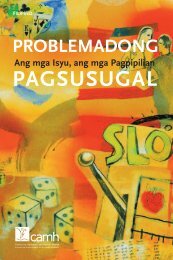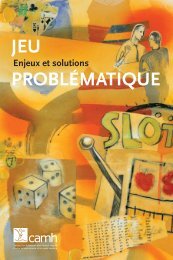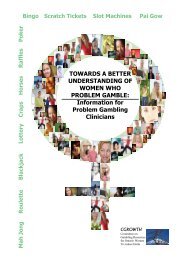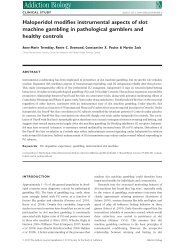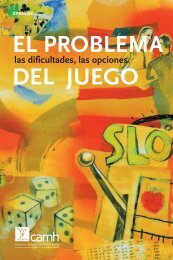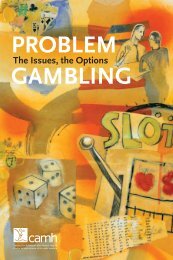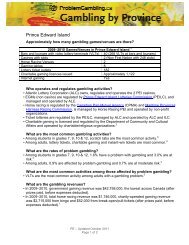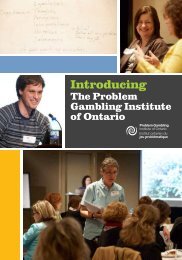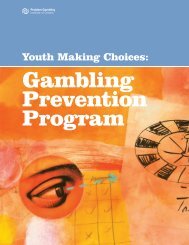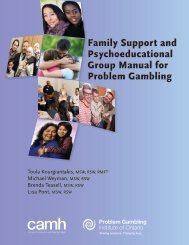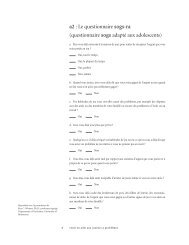Probability, Random Events, and the Mathematics of Gambling
Probability, Random Events, and the Mathematics of Gambling
Probability, Random Events, and the Mathematics of Gambling
You also want an ePaper? Increase the reach of your titles
YUMPU automatically turns print PDFs into web optimized ePapers that Google loves.
does an excellent job <strong>of</strong> creating r<strong>and</strong>om events. The amount <strong>of</strong> information needed to gain an<br />
edge in a game <strong>of</strong> chance is <strong>of</strong>ten extremely large. For example, no dice are perfectly cubed,<br />
<strong>and</strong> this will produce a slight bias. But <strong>the</strong> bias on a pair <strong>of</strong> casino dice might not show up<br />
until after several thous<strong>and</strong> bets, <strong>and</strong> even <strong>the</strong>n would most likely be too small to allow <strong>the</strong><br />
player to make money. So, while in <strong>the</strong>ory nothing is completely r<strong>and</strong>om, in practice many<br />
games produce events that are indistinguishable from being purely r<strong>and</strong>om.<br />
Generating <strong>R<strong>and</strong>om</strong> <strong>Events</strong><br />
The question “What is r<strong>and</strong>om?” descends from <strong>the</strong> realm <strong>of</strong> <strong>the</strong>ory into that <strong>of</strong> practice when<br />
we look at how <strong>the</strong> events which underlie most gambling games are produced. <strong>R<strong>and</strong>om</strong>ness<br />
should be thought <strong>of</strong> as an ideal that is never really obtained in practice. The gambling<br />
devices used by casinos, however, efficiently maximizing uncertainty, <strong>and</strong> <strong>the</strong> results<br />
produced by <strong>the</strong>se devices are close enough to truly r<strong>and</strong>om to be treated as such.<br />
Roulette<br />
The roulette wheel is a very efficient r<strong>and</strong>omizer. Non-linearity is ensured by <strong>the</strong> combination<br />
<strong>of</strong> friction, gravity, centrifugal motion, <strong>and</strong> bumps <strong>and</strong> obstacles. This complexity is<br />
magnified many times by <strong>the</strong> fact that <strong>the</strong> inner wheel spins in <strong>the</strong> direction opposite that in<br />
which <strong>the</strong> ball is thrown. Initial uncertainty is introduced into <strong>the</strong> game by <strong>the</strong> speed <strong>of</strong> wheel<br />
at <strong>the</strong> outset, <strong>the</strong> speed <strong>of</strong> <strong>the</strong> ball, <strong>the</strong> exact position <strong>of</strong> <strong>the</strong> ball <strong>and</strong> wheel, <strong>the</strong> weight <strong>and</strong><br />
bounciness <strong>of</strong> <strong>the</strong> ball <strong>and</strong> <strong>the</strong> air pressure <strong>and</strong> humidity. The outcome <strong>of</strong> a roulette wheel<br />
would be completely predictable if <strong>the</strong> ball were always thrown with exactly <strong>the</strong> same force<br />
from <strong>the</strong> exact same position <strong>and</strong> <strong>the</strong> speed <strong>of</strong> <strong>the</strong> wheel <strong>and</strong> all o<strong>the</strong>r environmental<br />
conditions were held exactly constant. In practice this is impossible; some croupiers,<br />
however, can apparently throw <strong>the</strong> ball with enough accuracy to hit a particular section <strong>of</strong> <strong>the</strong><br />
wheel (Bass, 1985). As a result some casinos require that <strong>the</strong> croupier not look at <strong>the</strong> wheel<br />
when throwing <strong>the</strong> ball.<br />
Dice<br />
The key to ensuring r<strong>and</strong>omness in dice is <strong>the</strong> combination <strong>of</strong> flat surfaces <strong>and</strong> sharp edges,<br />
coupled with <strong>the</strong> rolling <strong>of</strong> <strong>the</strong> dice, which makes it difficult to predict <strong>the</strong> outcome <strong>of</strong> a<br />
throw. In addition, <strong>the</strong> house rules for dice games specify that for a throw to be valid, <strong>the</strong> dice<br />
have to hit a bumper on <strong>the</strong> o<strong>the</strong>r side <strong>of</strong> <strong>the</strong> table, making it impossible to manipulate <strong>the</strong><br />
throw’s outcome. Dice used in home board games <strong>of</strong>ten have small holes drilled into <strong>the</strong> dice<br />
to mark <strong>the</strong> numbers. As a result <strong>the</strong> side with 6 dots is lighter than <strong>the</strong> opposite side, which<br />
has only 1 dot. This produces a slight bias, <strong>of</strong> 1% to 2%, that 6 <strong>and</strong> 5 will come up somewhat<br />
more <strong>of</strong>ten than <strong>the</strong>ir opposites, 1 <strong>and</strong> 2 respectively. In addition, <strong>the</strong> dice <strong>of</strong> some home<br />
15




